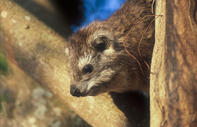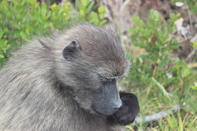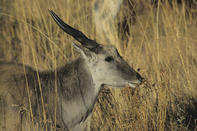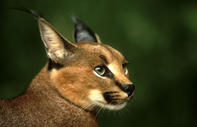Dassie-size Primitive Mammals
The first animals of the Drakensberg were mammal-like reptiles, creatures that predated the true dinosaurs by tens of millions of years, like the massive, lumbering Melanosaurus or the fleet-footed sharp-toothed Massospondylus found in the Red Bed deposits.

When driving across the Karoo and day-dreaming you can imagine there's a six-metre-tall Massospondylus reared up on its hind legs and then belting along the veld next to the car. Imagine coming across one in a forest of the Little Berg? Increasingly dry conditions drove these animals away, but dassie-size primitive mammals survived, probably because they were burrowing animals, and dassies are the evolutionary result of their tenacity.
Some of these creatures did leave their footprints for us to see, near Leribe in Lesotho and Giant's Castle Reserve. More important, they left their skeletons in the soft Stormberg rocks. Geologist and conservationist Gideon Groenewald has made a profession out of finding them and conducting 'dinosaur tours' in the Golden Gate area.
Organisms are Specially Adapted

Mountains are by their nature highly stressed environments and any organisms that exist in them have to become specially adapted. Jackals and baboons do it by being supremely versatile and opportunistic feeders while reptiles beat the harsh winter by going underground and hibernating.
Others, such as the Lammergeier and Grey rhebuck are specifically adapted physiologically and are highly specialised feeders. The problem with this group is: squeeze their habitat (overgrazing, hunting, fencing) and they have nowhere else to go. Some animals, such as baboons, jackals and grey rhebuck, are found at all altitudes in the Berg and it's a thrilling wilderness feeling when you're wakened by the cry of a jackal in the morning in a valley on the summit.
Others have more specific habitat preferences. For example, Lammergeiers nest in and cruise only above the highest crags and summit plateaux, dropping down to the Little Berg to look for carcasses.
Antelope of the Berg

Eland tend to stick to the grassy plateaux of the Little Berg, descending to the outer reaches of the foothills along the river valleys in winter, where they browse on Buddleja leaves. Oribi are synonymous with tall grassland where they will lie hidden till you are almost on top of them before they break cover in sometimes startling fashion.
Bushbuck - as their name implies - stick to the dense riverine bush and forest. You would expect Klipspringer to be fairly conspicuous in the subalpine and alpine zones, but in my experience they are scarce. Who knows what animals might have roamed the Berg summit in days gone by, but today the most frequently seen (in areas where herders don't live permanently) are Grey rhebuck. I've watched them doing territorial battle.
Two males will dash about the hillsides and valleys at top speed, covering up to five kilometres in the 10 minutes or so it has taken me to get my breath back after cresting a steep ridge. Truly humbling athleticism and on top of it they never seem to have to look where they're going over the broken ground.
Caracals and Snakes

Most guidebooks will tell you that Leopards occur in the Drakensberg, and they certainly did once, but these days people are yet to see any sign of them. What has been seen is the scat of large cats, or cat-like things. Big enough for a small leopard, but more likely a Caracal or a Serval.
You'll see plenty of small cat scat - mongooses, genets, African wild cat, African weasels and zorillas (striped polecat). Along the rivers there are plenty of scattered remains of crab shells, a sign that otters are about, as well as the large and somewhat scruffy water mongoose. We all have our phobias, and most hikers seem to have an irrational fear of snakes.
The thing with snakes, as indeed just about all animals, is that they're far more scared of big lumbering you than you are of them. The chances of seeing a snake are really very small. The chances of seeing a poisonous snake remote, and the chances of being bitten by one are microscopic. Sure, they are there (and I seem to come across far, far more than my share) but wear a decent pair of boots and you reduce the chances of a bite to close to zero.